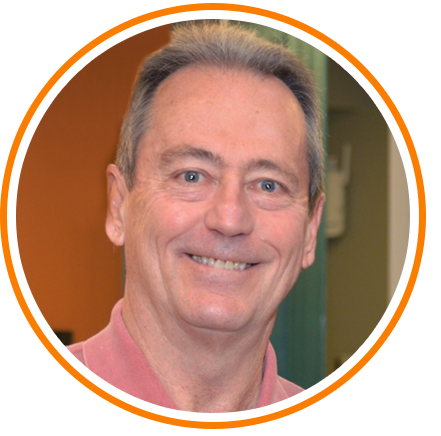
John's story
Stroke survivor
John is not your typical stroke survivor.
"Most people have a stroke, they fall down, someone calls an ambulance, and they get blood thinners," John says. "I didn't get any of that."
Nope, John did it the hard way. By the time doctors were able to fix what was wrong and Dr. Andrew Ringer became involved in his care, John had already suffered several strokes. "I had my first episode around Easter, and my surgery was around the 4th of July," John says. "I had to spend three months or so not knowing whether I would wake up or stand up without feeling like I would fall down."
The strokes cost John his career, stole some of his brainpower, and left him "the D player" in a golfing foursome. But the strokes didn't take his resolve.
It is a tribute to both John, a former farmer, home-builder and subcontract inspector for FEMA, and Dr. Ringer, a neurosurgeon with Mayfield Brain & Spine, that to date John has played more than 80 of the Golf Digest Top 100 list of courses. And counting. He has been so successful as a golf-playing stroke survivor, in fact, that he recently returned to Dr. Ringer for help with his aching back. (More about that later.)

John and Dr. Ringer
First inkling of a problem
John's neurovascular difficulties began in 2010. He was 59 and, like many people that age, had a few risk factors. He had a past history of smoking. He had put on a few pounds. He didn't have a primary care physician. (Ouch.) And there was family history; his father had suffered a stroke and had undergone a heart bypass. At the same time, John exercised regularly, played lots of golf, and worked his own organic garden. "I tried to take care of myself, not that I didn't have my vices being a former smoker," John says.
John has vivid memories of the first signs of trouble. "I had walked 18 holes on Thursday. I woke up on a Friday morning and had a really weird episode that lasted about 30 seconds. I had balance loss and heard strange sounds, almost like an electronic synthesizer. Then it went away. I didn't feel good. I was supposed to play golf on Saturday, and on Friday night I called and cancelled. Saturday morning I woke up and the same thing happened. I had a momentary loss of balance, I heard weird noises, and I didn't feel right. I felt a little queasy."
John hustled over to urgent care. "What you're describing sounds like a stroke," the clinician told him, "though you don't look as though you've had a stroke. I'm sending you to the hospital."
The hospital performed a scan, John recalls, and advised him that he had not suffered a stroke. "They said, 'You have vertigo; go home and stay in bed,'" John recalls.
But the trouble persisted. He woke up in the middle of the night feeling nauseated, and by Monday he was bumping into walls. He returned to the hospital, and this time a scan did reveal evidence of a stroke.
John was referred to a neurologist who recognized that the answer to John's problem was not clear-cut. John recalls her telling him to go home and relax and not do anything strenuous. A request for an angiogram, a test that would provide a better look at John's arteries, was delayed by insurance issues. During the delay, John had more small strokes.
The problem was in his vertebral arteries, two important arteries that – when working properly -- provide blood flow to the lower and back areas of the brain, including the cerebellum, which coordinates muscle movements and maintains balance. John's left vertebral artery had narrowed because of a progressive buildup of plaque and was now nearly closed off because of a clot. His right vertebral artery was deformed and most likely had never been fully functional.
Insurance delays stemmed from the fact that treatment was not straightforward, Dr. Ringer explains. "This was something for which we don't have as much scientific data, and the right answer isn't always clear. Unfortunately, in the time that it took us to get the insurance to agree to let us take a look at what we thought was going on, that artery had gone from bad to narrow to completely blocked off."
Treatment would involve a cerebral bypass, a delicate procedure in which Dr. Ringer would open John's skull and surgically reroute the blood flow. Pointing to the back of his head, Dr. Ringer explains: "We took the occipital artery here, on the back of the skull, and plugged it into his vertebral artery well past the point of the blockage so that now we could get blood flow back into that artery to provide normal supply to the back of the brain. I tell patients it's like taking 275 to get around a traffic jam on 75. You just go around the block and come out on the other end."
Hardship, and recovery, after a stroke
John shares his story to give other survivors hope. "Right after a stroke, you're so lost," he says. "Your brain isn't working right, and your body isn't working right. My balance for instance. I was 59, and suddenly I had to hold onto walls. I don't know how to explain how powerful the uncertainty is and how afraid you are. I wish there was a better way to tell people who've had a stroke that there is hope. Just don't give up!"
Recovery was not easy. John struggled with balance problems and had to retire from his job, which had taken him to dozens of FEMA disaster sites, including New York City after 9-11 and New Orleans after Hurricane Katrina. Although he believes he's "still reasonably sharp," he admits that he is not 100 percent. Nevertheless, life is good.
"In addition to the support I received from family and friends, especially my golf buddies, I'd say I owe it to being persistent," John says. "I'll be damned if I'm not going to enjoy the rest of my time left. In addition to a return to the game I've enjoyed since childhood, I decided I would renovate my yard as extra therapy. It was dated and overgrown. I dug some holes myself, even though I sat on the ground when I did it. I put low stone walls around the beds. These were things I knew how to do from prior experience in farming and construction."
Playing golf without balance was not easy, but within a year John was back on the golf course. An experienced traveler, he adopted the challenge of playing the top 100 golf courses. "I had already collected 20 of the more famous courses," John says. "I'm now at 83, and that's the reason I just came in again to see Dr. Ringer. With farming and construction in my background, I've had back pain since my early thirties. I didn't know about the bend-at-the-knees-when-lifting thing. I was used to my back being stiff and sore in the morning, but then I started getting numbness in my good leg. On my last trip, I could hardly walk."
Looking back, Dr. Ringer reflects that John did so well after his surgical bypass that, after his three-month follow-up appointment, "He didn't need to come see me again … until 8 years later when he had back pain and leg pain." Dr. Ringer performed a minimally invasive procedure at TriHealth's Good Samaritan Hospital. John arrived at 8 a.m. and left by 4 p.m.
"I was tickled pink to get to Dr. Ringer for my back surgery," John says. "The fact that he pulled off what he did with my brain surgery, I figured he could possibly fix this too. As soon as I woke up, that pinched nerve feeling I had anytime I put weight on my right leg was gone. I don't think all my back pain will go away, but the pinched nerve, which would have kept me from doing any more golf trips, is gone."

John enjoys working in his organic garden.
Meanwhile, John continues to enjoy his yard, which features five fruit trees, strawberries, blueberries, blackberries, a grapevine and a 600-square-foot garden, all organic. "I've been into natural foods for a long time," he says. "I think the less pesticides I eat, the better off I am. Besides golf and gardening, I enjoy grilling, listening to music on the deck, even watching birds. I just enjoy being outside so much."
~ Cindy Starr
Hope Story Disclaimer -"John's Story" is about one patient's health-care experience. Please bear in mind that because every patient is unique, individual patients may respond to treatment in different ways. Results are influenced by many factors and may vary from patient to patient.
